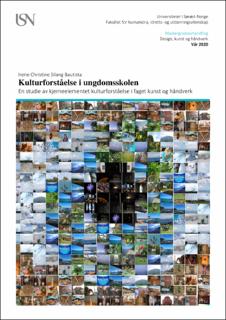Kulturforståelse i ungdomsskolen: En studie av kjerneelementet kulturforståelse i faget kunst og håndverk
Master thesis
Permanent lenke
https://hdl.handle.net/11250/2659887Utgivelsesdato
2020Metadata
Vis full innførselSamlinger
Sammendrag
Bakgrunnen for denne studien kommer av fagfornyelsen i 2020. Et av tiltakene for å
forbedre undervisningskvaliteten er innføringen av kjerneelementer i hvert fag – en
samling av elementer som utgjør fagets egenverdi og en beskrivelse av de viktigste
kompetansene elevene må tilegne seg i faget. Denne masteroppgaven handler om
kjerneelementet kulturforståelse med problemstillingen: Hva kan kjerneelementet
kulturforståelse innebære i kunst og håndverksundervisningen, og hvordan kan lærere
tilrettelegge for det gjennom estetiske læreprosesser i ungdomsskolen?
For å besvare denne problemstillingen har jeg benyttet meg av litteraturstudie,
kvalitativt forskningsintervju og analyse av eget skapende arbeid. Teoridelen åpner med
et historisk tilbakeblikk på kulturaspektets plass i læreplanen. Deretter tar
litteraturstudiet for seg teorien om kulturbegrepet, didaktikk og estetikk. Teoretikere
jeg har basert oppgaven på er blant andre Else Marie Halvorsen, Malcolm Ross, Lev
Vygotsky, Bennyé Austring og Merete Sørensen. Datagrunnlaget fra intervjuene er
hentet fra fire informanter – tre formidlere eller formidlingsledere og et medlem fra
læreplangruppa i kunst og håndverk. Erfaringsbaserte data fra det skapende arbeidet er
dokumentert i en personlig loggbok og videre utarbeidet i et estetisk skapende arbeid.
På bakgrunn av disse undersøkelsene skisserer jeg forslag til undervisningsopplegg og
vurderingsskjema hvor kulturforståelse er temaet.
Det ikke et fasitsvar til hvordan man skal formidle kultur i klasserommet. Formidlingen
er avhengig av gruppesammensetninger, rammefaktorer og lærerens forutsetninger.
Noen råd som fremheves er virkelighetsnære-, meningsfulle- og taktile oppgaver i
arbeid med formidling av kultur i kunst og håndverk. Kunnskapen elevene tilegner seg
skal brukes til å forsterke elevenes holdninger, toleranse og forståelse for andres
kulturer. På grunn av den stadige økningen av globalisering er det nå spesielt viktig med
slike kompetanser i vårt flerkulturelle samfunn. Avslutningsvis drøftes ulike perspektiver
på kulturforståelse og det diskuteres forslag til videre studie.
ABSTRACT
The background for this study is based on the elaboration of a new national curriculum
(K20). One of the measures to improve the quality of teaching is the introduction of
core elements in each subject – a collection of elements that amounts to the subject’s
characteristics and a description of the most important competences the pupils have to
acquire in the subject. The theme of this master’s thesis is the core element, cultural
understanding, with its topic question: What can the core element cultural
understanding involve in the subject of arts and craft and how can teachers facilitate
this kind of teaching in lower secondary school?
I have used literature study, qualitative research interview and an analysis of my own
creative work in order to answer the question. The theory section commences with a
historical view on cultural aspect’s place in the curriculum. It proceeds by dealing with
theory of the concept of culture, didactic and aesthetic. I have based this study on many
theorists such as Else Marie Halvorsen, Malcolm Ross, Lev Vygotsky, Bennyé Austring
and Merete Sørensen. The data from the interviews are based on four informants –
three intermediaries or dissemination managers and a member of the curriculum group
in arts and crafts. The experience-based data from the creative work is documented in a
personal journal and worked on in an aesthetically creative process. Based on these
findings, I am presenting a proposition of a lecture plan and an assessment criterion
that solely emphasizes the topic of cultural understanding.
In conclusion, there is no right formula on how to convey cultural understanding in the
classroom. It all depends on the pupils, accession and the teacher’s capabilities.
However, some advices were emphasized more than others; realistic near-, meaningfuland
tactile tasks. The knowledge the pupils allocates are meant to be used to improve
the pupils’ attitudes, tolerance and understanding of other cultures. It is especially
important with these types of competences now that the society is multicultural and of
globalization. Also, there will be a focus on the higher cognitive abilities in the arts and
craft classroom. Lastly, there is a discussion of different aspects of cultural
understanding and a suggestion of further study on this subject.
